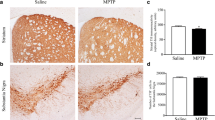Abstract
1-methyl-4-phenyl-1,2,3,6-tetrahydropyridine (MPTP) intoxicated mice have been widely used to model the loss of dopaminergic neurons. As this treatment leads to basal ganglia degeneration, it was proposed that MPTP mice could be used as a model of Leigh syndrome. However, this mitochondrial pathology is biochemically characterized by a respiratory chain dysfunction. To determine if MPTP can affect in vivo mitochondria function, we measured the activities of mitochondrial respiratory chain complexes in several tissues. Our results show that MPTP affects mainly mitochondrial respiratory chain complex IV, as found in Leigh Syndrome, confirming that acute MPTP intoxicated mice are a good model of Leigh Syndrome.




Similar content being viewed by others
References
Battino M, Littarru GP, Gorini A, Villa RF (1996) Coenzyme Q, peroxidation and cytochrome oxidase features after parkinson’s-like disease by MPTP toxicity in intra-synaptic and non-synaptic mitochondria from Macaca fascicularis cerebral cortex and hippocampus: action of dihydroergocriptine. Neurochem Res 21:1505–1514
Billett EE (2004) Monoamine oxidase (MAO) in human peripheral tissues. Neurotoxicology 25:139–148. doi:10.1016/S0161-813X(03)00094-9
Burke RE, O’Malley K (2013) Axon degeneration in Parkinson’s disease. Exp Neurol 246:72–83. doi:10.1016/j.expneurol.2012.01.011
Desai VG, Feuers RJ, Hart RW, Ali SF (1996) MPP(+)-induced neurotoxicity in mouse is age-dependent: evidenced by the selective inhibition of complexes of electron transport. Brain Res 715:1–8. doi:10.1016/0006–8993(95)01255-9
DiMauro S, Schon EA (2003) Mitochondrial respiratory-chain diseases. N Engl J Med 348:2656–2668. doi:10.1056/NEJMra022567
Duty S, Jenner P (2011) Animal models of Parkinson’s disease: a source of novel treatments and clues to the cause of the disease. Br J Pharmacol 164:1357–1391. doi:10.1111/j.1476-5381.2011.01426.x
Gerards M, Sallevelt SC, Smeets HJ (2016) Leigh syndrome: Resolving the clinical and genetic heterogeneity paves the way for treatment options. Mol Genet Metab 117:300–312. doi:10.1016/j.ymgme.2015.12.004
Korecka JA, Eggers R, Swaab DF, Bossers K, Verhaagen J (2013) Modeling early Parkinson’s disease pathology with chronic low dose MPTP treatment. Restor Neurol Neurosci 31:155–167. doi:10.3233/RNN-110222
Lagrue E et al (2009) MPTP intoxication in mice: a useful model of Leigh syndrome to study mitochondrial diseases in childhood. Metab Brain Dis 24:321–335. doi:10.1007/s11011-009-9132-y
Lake NJ, Compton AG, Rahman S, Thorburn DR (2016) Leigh syndrome: one disorder, more than 75 monogenic causes. Ann Neurol 79:190–203. doi:10.1002/ana.24551
Mazzio EA, Soliman KF (2003) Cytoprotection of pyruvic acid and reduced beta-nicotinamide adenine dinucleotide against hydrogen peroxide toxicity in neuroblastoma cells. Neurochem Res 28:733–741
Medja F et al (2009) Development and implementation of standardized respiratory chain spectrophotometric assays for clinical diagnosis. Mitochondrion 9:331–339. doi:10.1016/j.mito.2009.05.001
Osman MY, Osman HM (2008) Inhibitory effect of acetylcholine on monoamine oxidase A and B activity in different parts of rat brain. Arzneimittel-Forschung 58:493–496. doi:10.1055/s-0031-1296546
Pain S, Gochard A, Bodard S, Gulhan Z, Prunier-Aesch C, Chalon S (2013) Toxicity of MPTP on neurotransmission in three mouse models of Parkinson’s disease Experimental and toxicologic pathology : official journal of the Gesellschaft fur Toxikologische Pathologie 65:689–694 doi:10.1016/j.etp.2012.09.001
Pastoris O, Dossena M, Foppa P, Catapano M, Ferrari R, Dagani F (1995) Biochemical evaluations in skeletal muscles of primates with MPTP Parkinson-like syndrome Pharmacological research : the official journal of the Italian Pharmacological Society 31:361–369
Perry CG, Lally J, Holloway GP, Heigenhauser GJ, Bonen A, Spriet LL (2010) Repeated transient mRNA bursts precede increases in transcriptional and mitochondrial proteins during training in human skeletal muscle. J Physiol 588:4795–4810. doi:10.1113/jphysiol.2010.199448
Rahman S et al (1996) Leigh syndrome: clinical features and biochemical and DNA abnormalities. Ann Neurol 39:343–351. doi:10.1002/ana.410390311
Ransom BR, Kunis DM, Irwin I, Langston JW (1987) Astrocytes convert the parkinsonism inducing neurotoxin, MPTP, to its active metabolite, MPP+. Neurosci Lett 75:323–328
Rocher C et al (2008) Influence of mitochondrial DNA level on cellular energy metabolism: implications for mitochondrial diseases. J Bioenerg Biomembr 40:59–67. doi:10.1007/s10863-008-9130-5
Rossignol R, Letellier T, Malgat M, Rocher C, Mazat JP (2000) Tissue variation in the control of oxidative phosphorylation: implication for mitochondrial diseases. Biochem J 347(Pt 1):45–53
Rousselet E et al (2003) Behavioral changes are not directly related to striatal monoamine levels, number of nigral neurons, or dose of parkinsonian toxin MPTP in mice. Neurobiol Dis 14:218–228
Smeyne RJ, Jackson-Lewis V (2005) The MPTP model of Parkinson’s disease. Brain Res Mol 134:57–66. doi:10.1016/j.molbrainres.2004.09.017
Stephenson D et al (2007) Quantification of MPTP-induced dopaminergic neurodegeneration in the mouse substantia nigra by laser capture microdissection. J Neurosci Methods 159:291–299. doi:10.1016/j.jneumeth.2006.07.027
Sundar Boyalla S, Barbara Victor M, Roemgens A, Beyer C, Arnold S (2011) Sex- and brain region-specific role of cytochrome c oxidase in 1-methyl-4-phenylpyridinium-mediated astrocyte vulnerability. J Neurosci Res 89:2068–2082. doi:10.1002/jnr.22669
Acknowledgments
This work was supported by Association contre les Maladies MItochondriales (A.M.M.I.). The authors wish to thank Dr. S. Schriner for stimulating discussion.
Author information
Authors and Affiliations
Corresponding author
Ethics declarations
Conflict of interest
The authors declare that they have no conflicts of interest with the contents of this article.
Ethical approval
All applicable international, national, and/or institutional guidelines for the care and use of animals were followed. This article does not contain any studies with human participants performed by any of the authors.
Author contribution statement
BD and ED carried out experiments, collected and analyzed data, prepared the manuscript. LL and SB participated in experiments related to animal handling. PC participated in designing the experiments and reviewing the manuscript. TL contributed for data analysis and reviewed the manuscript. CR conceived experiments and contributed for analyzing data, preparing and reviewing the manuscript. All authors read and approved the final manuscript.
Additional information
Barbara DA COSTA and Elodie DUMON contributed equally to the work
Rights and permissions
About this article
Cite this article
Da Costa, B., Dumon, E., Le Moigno, L. et al. Respiratory chain inhibition: one more feature to propose MPTP intoxication as a Leigh syndrome model. J Bioenerg Biomembr 48, 483–491 (2016). https://doi.org/10.1007/s10863-016-9683-7
Received:
Accepted:
Published:
Issue Date:
DOI: https://doi.org/10.1007/s10863-016-9683-7




